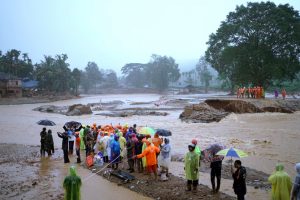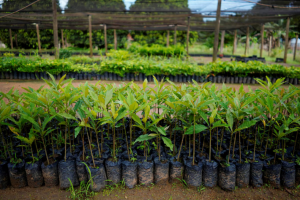Rapidly warming climate worsened rain in India’s southern state of Kerala, leading to fatal landslides that killed hundreds of people last month, a new study has found.
The Wayanad region in Kerala saw torrential downfalls last month, which triggered two landslides, a bridge collapse and flash floods so strong that they swept an entire village away.
More than 400 people are dead as a result of the carnage, while more than 10,000 have been displaced, according to Indian media reports.
Also on AF: Firms May Abandon Net-Zero Plans Amid Carbon Offset Uncertainty
The 2,132 square-kilometre district is prone to landslides due to its hilly terrain combined with heavy rainfall and recent uptick in deforestation. Over-development and unchecked tourism in the state are now worsening the region’s risks, experts say.

The disaster last month was the worst to hit the region since 2018 — when it suffered heavy floods and 72 landslides.
A new study released on Wednesday said July’s landslides in Wayanad were exacerbated by climate change, which made single-day monsoon downpours in the region 10% heavier.
The study, by the World Weather Attribution group, which examines the role of climate change in extreme weather, also said one-day bursts of rain in Kerala will become another 4% heavier if the world does not move away from fossil fuels and global warming reaches 2 degrees Celsius.
Why does global warming cause heavier rain?
Climate change tends to affect the intensity and frequency of rain as it increases the amount of water that evaporates into the atmosphere from warmer oceans.
Resulting weather systems lead to torrential rainfall and intense snow storms, which in turn cause floods and related disasters.
Asian economies have been particularly vulnerable to climate change-linked disasters.

The World Meteorological Organisation noted in a study in April that 80% of the climate and related extreme weather events in Asia in 2023 were caused by floods and storms. Those events caused the highest number of casualties and economic losses, the report said.
Within the region, India and China — two of the world’s most populated countries — have been most vulnerable to torrential rainfall in recent years. That has led both countries to ask for ‘trillions’ worth of climate finance from wealthier countries.
In China, extreme weather events led to economic losses of more than $10 billion last month alone. Excessive rain and related disasters accounted for 88% of those losses.
Similarly, floods in North India in July last year caused losses worth at least $1.2 billion last year, according to government estimates.
Last month’s losses in Wayanad, meanwhile, are expected to be around $143 million, officials say.
What can authorities do?
While addressing the global carbon footprint remains critical to limiting the growing risks of climate change, the WWA study recommended additional measures for the protection of vulnerable regions like Wayanad.
In its study, the group recommended authorities minimise deforestation and quarrying, reinforce susceptible slopes, and build retaining structures to prevent Wayanad-like disasters in future.
“In addition to mitigation, adaptation is critical”, said Maja Vahlberg, one of the authors of the study, calling for more stringent assessment of landslides and better early warning and evacuation systems.
- Reuters, with additional editing and inputs from Vishakha Saxena
Also read:
China Central Bank Vows $14bn to Rebuild Flooded Farm Areas
India’s Surging Economy at Risk From Severe Water Shortages
India Taps AI in Forecasts as Extreme Weather Weighs on Economy
India Solar Output Slowest in 6 Years Amid Scorching Heatwave
Hundreds Die in Extreme Heat at Haj, Millions Swelter Across Asia
China, US, India Face Climate Change Debt-Cost Time Bomb
Oil Producers, Carmakers Knew of Climate Risk in 1954 – Guardian
Methane Emissions Surge, Fuelling Climate Fears – Guardian
Tokyo Turns to AI For Earthquake Early Warning System – Kyodo
























